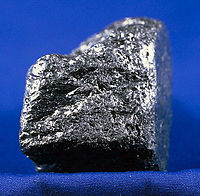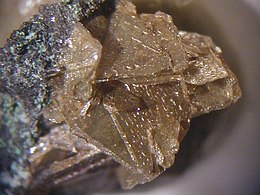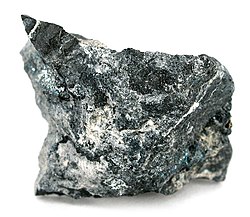Geominerals/Crystallogens

Def. any "member of the carbon group [(group 14)][1] of elements"[2] is called a crystallogen.
The carbon group is a periodic table group consisting of carbon (C), silicon (Si), germanium (Ge), tin (Sn), lead (Pb), and flerovium (Fl) that lies within the p-block.
The International Union of Pure and Applied Chemistry (IUPAC) notation, calls the carbon group group 14, semiconductor physics, calls them group IV, once also known as the tetrels (from the Greek word tetra, which means four), stemming from the Roman numeral IV in the group names, or (not coincidentally) from the fact that these elements have four valence electrons, also known as the crystallogens[3] or adamantogens.[4]
Like other groups, the members of this family show patterns in electron configuration, especially in the outermost shells, resulting in trends in chemical behavior:
| Atomic number (Z) | Chemical element | No. of electrons/shell | Nomenclatures |
|---|---|---|---|
| 6 | Carbon | 2, 4 | Carbonides |
| 14 | Silicon | 2, 8, 4 | Siliconsides |
| 32 | Germanium | 2, 8, 18, 4 | Germanides |
| 50 | Tin | 2, 8, 18, 18, 4 | Stannides |
| 82 | Lead | 2, 8, 18, 32, 18, 4 | Plumbides |
| 114 | Flerovium | 2, 8, 18, 32, 32, 18, 4 (predicted) | Fleroviides |
The image on the right shows a diamond from South Africa, 1.31 carats, 7 x 6 x 6 mm, a truly exquisite, super sharp, octahedral crystal of superior quality for a specimen. The graphite is from El Cochi, Sonora, Mexico, thumbnail, 2.5 x 2.4 x 1.2 cm, a crudely crystallized graphite, colored battleship gray with a resinous luster.
Carbonides
[edit | edit source]
Carbonides are naturally occurring minerals composed of 50 atomic percent, or more, carbon. Carbonide-like minerals with greater than 25 at % carbon are also included. This separates carbon containing minerals from carbonates which are at most 25 at % carbon.
Diamonds
[edit | edit source]
Def. "[a] naturally occurring, glimmering glass-like allotrope of carbon in which each atom is surrounded by four others in the form of a tetrahedron"[5] is called a diamond.
The diamond imaged on the right has been estimated to be just over 1.5 carats. It measures 5 mm on edge. Although it might seem small, it has wonderful visual impact because of the clarity and perch on matrix. Embedded perhaps 50% in the matrix, so you know it is real. What is more, you can look right through the diamond to the matrix underneath! Around the diamond is a thin white layer you sometimes see, which indicates not glue but rather an alteration in the surrounding rock due to the chemical heat of formation of the crystal and is a good indication of its origins as natural.
Graphites
[edit | edit source]
Graphite is a hexagonal form of carbon that often appears as tabular crystals.
Chaoites
[edit | edit source]Chaoites are another hexagonal form of native carbon. It occurs as "thin lamellae (3-15 microns wide), alternating with graphite and perpendicular to the {0001} face of graphite."[6]
"Occurs in association with graphite, zircon, and rutile in shocked graphite gneisses from Mottingen in the Ries Crater, Germany. Also observed from the Goalpara and Dyalpur carbonaceous chondrites."[6]
Fullerites
[edit | edit source]Fullerite appears to be a tentative name for the mineral occurrence of buckyballs.
"By means of high-resoluton transmission electron microscopy, both C60 and C70 fullerenes have been found in a, carbon-rich Precambrian rock from Russia The fullerenes were confirmed by Fourier transform mass spectrometry with both laser desorption and thermal desorption/electron-capture methods to verify that the fullerenes were indeed present in the geological sample".[7]
Organic minerals
[edit | edit source]An organic mineral appears to be a naturally occurring mineral containing one or more organic chemicals at a concentration of greater than 25 molecular %.
Abelsonites
[edit | edit source]
Abelsonites have a chemical formula of NiC31H34N4, for 44.3 at % carbon.[6]
Carpathites
[edit | edit source]

Carpathite (aka Karpatite) is a very rare organic species (C24H12).[6] It is a polycyclic aromatic hydrocarbon (PAH). This specimen is from the old Picacho Mercury Mine of California. It exhibits a radial spray of highly lustrous, canary-yellow carpathite lathes to 2.0 cm on drusy quartz. Another crossed cluster of crystals above reach 3.0 cm. It has 66.7 at % carbon.
Evenkites
[edit | edit source]
Evenkite has about 32.4 at % carbon in its formula: (CH3)2(CH2)22.[6]
Fichtelites
[edit | edit source]Def. a "rare white monoclinic organic mineral, [7-isopropyl-1,4a-dimethyl-dodecahydro-1H-phenanthrene (C19H34)],[8] found in fossilized wood"[9] is called a fichtelite.
Also, occurs in "fossilized pine wood from a peat bog; in organic-rich modern marine sediment."[10]
Fichtelites have about 35.8 at % carbon.
Hartites
[edit | edit source]
Hartites have about 37 at % carbon with a formula of C20H34.[6]
Hoelites
[edit | edit source]
Hoelites are 50 at % carbon with a formula of (C6H4)2(CO)2.[6]
Idrialites
[edit | edit source]
With a formula of C22H14,[6] idrialites are about 61 at % carbon.
Idrialite is "a complex natural mineral composed entirely of cata-condensed polyaromatic hydrocarbons (PAHs), usually containing a thiophenic or aliphatic five-membered ring."[11]
Idrialite "(and also curtisite) represents more complex mixtures of chain-type PAHs with molecular weights ranging from 216 to 372 amu [5]."[11]
"Some of the bands in the idrialite spectra are attributed to specific vibrational modes of thiophene or fluorene-type PAHs, especially in the region bellow 1000 cm−1. These modes at 495, 705 and 750 cm−1 along with C–H or C–H2 stretching modes around 3000 cm−1 can be then used to distinguish such groups of PAHs in complicated organic mineral mixtures like idrialite."[11]
Idrialite may include benzonaphthothiophenes (chemical formula: C16H10S).[11]
Kratochvilites
[edit | edit source]Def. a "rare organic mineral [C14H10 or (C6H4)2CH2, a polymorph of fluorene], an orthorhombic hydrocarbon formed by combustion of coal or pyritic black shale deposits"[12] is called kratochvilite
Kratochvilites have about 58.3 at % carbon.
Moissanite
[edit | edit source]
Moissanite is native SiC.[6]
Simonellites
[edit | edit source]
Def. an "orthorhombic-dipyramidal white mineral containing carbon and hydrogen [C19H24]"[13] is called a simonellite.
Simonellites have about 44.2 at % carbon.
Carbonates
[edit | edit source]Siliconides
[edit | edit source]Silicates
[edit | edit source]Germanides
[edit | edit source]Germanites
[edit | edit source]The sample of germanite on the right has a composition of Cu26Fe4Ge4S32. Generally, germanite has a composition closer to Cu3(Ge, Ga, Fe, Zn) (S,As)4.[6] "This sample also contains tennantite."[14]
Stannides
[edit | edit source]
Native tin such as in the images on the right occurs in two crystal forms: α-Sn (cubic) and β-Sn (tetragonal).[6]
Abhurites
[edit | edit source]
Abhurite (IMA symbol: Abh[15]) is a mineral of tin, oxygen, hydrogen, and chlorine with the formula Sn
21O
6(OH)
14Cl
16[16][17] or Sn
3O(OH)
2Cl
2.[18] It is named after its type locality, a shipwreck with tin ingots at Sharm Abhur, a cove near Jeddah in the Red Sea. Abhurite forms alongside other tin minerals like romarchite and cassiterite.[19]
Abhurite formed on tin materials when in contact with sea water. The mineral was described in 1977 from a shipwreck near Hidra Island, Norway, where it occurred on pewter plates. However, that report was not recognized by the IMA, International Mineralogical Association.[17] Along with Sharm Abhur and the shipwreck near Hidra Island, abhurite was found on tin ingots in the Uluburun shipwreck. On the ingots, it was found with other tin minerals like cassiterite and romarchite, and calcium carbonate minerals like calcite and aragonite.[20]
Plumbides
[edit | edit source]

"Diamond cubic structures with lattice parameters around the lattice parameter of silicon exists both in thin lead and tin films, and in massive lead and tin, freshly solidified in vacuum of ≈5 x 10-6 Torr. Experimental evidence for almost identical structures of at least three oxide types is presented, demonstrating that lead and tin behave like silicon not only in the initial stages of crystallization, but also in the initial stages of oxidation."[21]
The piece of native lead on the right shows a relatively sharp, and well-formed cuboctahedron of Lead at the top of the specimen, which is associated with elongated crystals on the base and back.
Its source locality is Långban, Filipstad, Värmland, Sweden.
A fresh surface of high purity lead on the left is silvery in appearance.
Altaites
[edit | edit source]
Altaite has the chemical formula of PbTe. It has face-centered cubic structure with four formula molecules (Z=4) per unit cell. It is 50 atomic percent lead and 50 at. % tellurium. Crystal habits include cubic and octahedral crystals; but much more commonly found in massive and granular forms.
Clausthalites
[edit | edit source]
Clausthalite is a lead selenide mineral, with chemical formula PbSe. It is a face-centered mineral with Z = 4 formula units per unit cell.
Galenas
[edit | edit source]
Galena in the image on the right is the metallic cuboidal crystal atop a matrix. Galena is PbS, 50 atomic % lead and 50 atomic % sulfur. Each cubic unit cell contains four PbS molecules in a face-centered cubic lattice.
Litharges
[edit | edit source]Litharge is one of the natural mineral forms of lead(II) oxide, PbO. Litharge is a secondary mineral which forms from the oxidation of galena ores. It is a coating and encrustation with internal tetragonal crystal structure. It is dimorphous with the orthorhombic form massicot. Z = 2.
Massicots
[edit | edit source]
Massicot is lead (II) oxide mineral with an orthorhombic lattice structure, Z = 4.
Miniums
[edit | edit source]
Minium is a lead tetroxide mineral with the chemical formula: Pb2+2Pb4+O4, Pb
3O
4, also known as red lead. Minium has a light-to-vivid red and may have brown-to-yellow tints. It typically occurs in scaly-to-earthy masses. It crystallizes in the tetragonal crystal system.[22]
Minium has 42.9 at. % lead.
Plattnerites
[edit | edit source]
Plattnerite is a lead oxide mineral. It is the beta crystalline form (β-PbO2) of lead dioxide. It has a tetragonal structure with Z = 2 formula units.
Scrutinyites
[edit | edit source]2, specimen is from the Snake Pit Mine, Mex-Tex Mine, Bingham, Hansonburg District, Socorro Co., New Mexico, USA. Credit: Maggie Wilson, with written permission.{{fairuse}}
Scrutinyite (α-PbO2) is the alpha form of lead dioxide. The orthorhombic unit cell has Z = 4 chemical formula units.
In the image on the right, the Scrutinyite consists of brown to black micro crystals on quartz.
Fleroviides
[edit | edit source]Hypotheses
[edit | edit source]- Variations in rocks from one mineral composition into another can occur with each rock type.
See also
[edit | edit source]References
[edit | edit source]- ↑ SemperBlotto (4 March 2018). "crystallogen". San Francisco, California: Wikimedia Foundation, Inc. Retrieved 18 November 2021.
{{cite web}}:|author=has generic name (help) - ↑ SemperBlotto (8 June 2012). "crystallogen". San Francisco, California: Wikimedia Foundation, Inc. Retrieved 18 November 2021.
{{cite web}}:|author=has generic name (help) - ↑ Liu, Ning; Lu, Na; Su, Yan; Wang, Pu; Quan, Xie (2019). "Fabrication of g-C3N4/Ti3C2 composite and its visible-light photocatalytic capability for ciprofloxacin degradation". Separation and Purification Technology 211: 782–789. doi:10.1016/j.seppur.2018.10.027. https://www.researchgate.net/publication/317583451. Retrieved 17 August 2019.
- ↑ W. B. Jensen, The Periodic Law and Table.
- ↑ diamond. San Francisco, California: Wikimedia Foundation, Inc. October 16, 2012. http://en.wiktionary.org/wiki/diamond. Retrieved 2012-10-23.
- ↑ 6.00 6.01 6.02 6.03 6.04 6.05 6.06 6.07 6.08 6.09 6.10 Willard Lincoln Roberts; George Robert Rapp Jr.; Julius Weber (1974). Encyclopedia of Minerals. New York, New York, USA: Van Nostrand Reinhold Company. pp. 121-2. ISBN 0-442-26820-3.
- ↑ Peter R. Buseck; Semeon J. Tsipursky; Robert Hettich (10 July 1992). "Fullerenes from the Geological Environment". Science 257 (5067): 215-7. doi:10.1126/science.257.5067.215. http://www.sciencemag.org/content/257/5067/215. Retrieved 2015-07-30.
- ↑ SemperBlotto (15 March 2014). "fichtelite". San Francisco, California: Wikimedia Foundation, Inc. Retrieved 2015-01-09.
{{cite web}}:|author=has generic name (help) - ↑ Equinox (28 September 2010). "fichtelite". San Francisco, California: Wikimedia Foundation, Inc. Retrieved 2015-01-09.
{{cite web}}:|author=has generic name (help) - ↑ R. Ruff (2005). "Fichtelite" (PDF). Mineral Data Publishing. Retrieved 2015-01-09.
- ↑ 11.0 11.1 11.2 11.3 Otakar Frank; Jan Jehlička; Howell G.M. Edwards (15 December 2007). "Raman spectroscopy as tool for the characterization of thio-polyaromatic hydrocarbons in organic minerals". Spectrochimica Acta Part A: Molecular and Biomolecular Spectroscopy 68 (4): 1065–9. doi:10.1016/j.saa.2006.12.033. http://www.sciencedirect.com/science/article/pii/S1386142506007621. Retrieved 2015-11-02.
- ↑ Equinox (27 October 2008). "kratochvilite". San Francisco, California: Wikimedia Foundation, Inc. Retrieved 2015-01-09.
{{cite web}}:|author=has generic name (help) - ↑ Equinox (4 September 2011). "simonellite". San Francisco, California: Wikimedia Foundation, Inc. Retrieved 2015-01-09.
{{cite web}}:|author=has generic name (help) - ↑ Warr, L.N. (2021). "IMA-CNMNC approved mineral symbols". Mineralogical Magazine 85: 291-320. https://www.cambridge.org/core/journals/mineralogical-magazine/article/imacnmnc-approved-mineral-symbols/62311F45ED37831D78603C6E6B25EE0A.
- ↑ Handbook of Mineralogy - Abhurite
- ↑ 17.0 17.1 Mindat.org - Abhurite
- ↑ Richard V. Gaines, H. Catherine W. Skinner, Eugene E. Foord, Brian Mason, and Abraham Rosenzweig: "James Dwight Dana's new mineralogy", p. 401. John Wiley & Sons, 1997
- ↑ Memet, J. B. (2007). "The corrosion of metallic artefacts in seawater: descriptive analysis". In Dillmann, P.. Corrosion of Metallic Heritage Artefacts: Investigation, Conservation and Prediction of Long Term Behaviour. Elsevier. pp. 152–169. doi:10.1533/9781845693015.152. ISBN 9781845693015.
- ↑ Vandiver, Pamela B.; Goodway, Martha; Mass, Jennifer L. (2002-01-01). Materials Issues in Art and Archaeology VI: Symposium Held November 26-30, 2001, Boston, Massachusetts, U.S.A.. Materials Research Society. ISBN 9781558996489. https://books.google.com/books?id=7YM-AQAAIAAJ&hl=en&sa=X&ved=0ahUKEwiv2dL5se_YAhUU7GMKHYrgBfQQ6AEISzAG.
- ↑ S.K. Peneva, K.D. Djuneva and E.A. Tsukeva (2 May 1981). "RHEED study of the initial stages of crystallization and oxidation of lead and tin". Journal of Crystal Growth 53 (2): 382-396. doi:10.1016/0022-0248(81)90088-9. http://www.sciencedirect.com/science/article/pii/0022024881900889. Retrieved 2017-12-13.
- ↑ Handbook of Mineralogy. http://rruff.geo.arizona.edu/doclib/hom/minium.pdf.
External links
[edit | edit source]- Office of Scientific & Technical Information
- Scirus for scientific information only advanced search
- USGS Photo Glossary of volcanic terms
